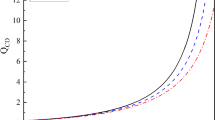Abstract
The FC-FNS fuel cycle model is used to calculate the hydrogen isotope flows in the fuel systems of a tokamak-based fusion neutron source (DEMO-FNS) with parameters R/a = 3.2 m/(L m), B = 5 T, Ip = 4–5 МА, PNBI = 30 MW, PECR = 6 MW, and DT fusion power Pfus = 40 MW. The FC-FNS (Fuel Cycle for Fusion Neutron Source) model has been significantly upgraded. For the first time, a joint simulation of gas, solid-state, and plasma flows of fuel mixtures in the regions of core and divertor plasma with the injection of neon impurity into the divertors was carried out. The possibility of reducing the fuel flows in the pumping and injection systems with the use of Ne impurity in the divertor has been substantiated. For the previously accepted scenarios of the D0 + T0 and D0 heating beam, the tritium inventories in the fuel systems were calculated taking into account the T breeding and burnup at a different T/D (fT) ratio in the core plasma. It was shown that, for the D + T beam, it is advisable use fT = 0.5, and for the D beam, it is more expedient to use fT = 0.6–0.7. The fuel injection was fundamentally revised. The main fueling method is injection of fuel pellets, which is now represented by separate D2, T2, and DT injectors and carried out from HFS and LFS. The DEMO-FNS injection system operating modes were analyzed as a function of the core parameters, and the gas flows were evaluated for various D2/T2/DT pellet-injector modes. The results obtained have allowed us to choose the fuel system configuration with the minimum tritium inventory (<2 kg) and the lowest reprocessing time.









Similar content being viewed by others
REFERENCES
B. V. Kuteev, Yu. S. Shpanskiy, and DEMO-FNS Team, Nucl. Fusion 57, 076039 (2017).
S. S. Ananyev, A. V. Spitsyn, and B. V. Kuteev, Fusion Eng. Des. 138, 289 (2019). https://doi.org/10.1016/j.fusengdes.2018.12.003
S. S. Anan’ev, E. D. Dlugach, A. I. Krylov, B. V. Kuteev, and A. A. Panasenkov, Vopr. At. Nauki Tekh., Ser.: Termoyad. Sintez 41 (1), 5 (2018). https://doi.org/10.21517/0202-3822-2017-41-1-5-17
S. S. Ananyev, A. V. Spitsyn, and B. V. Kuteev, Fusion Eng. Des. 109–111, 57 (2016).
S. S. Anan’ev and A. V. Spitsyn, Vopr. At. Nauki Tekh., Ser.: Termoyad. Sintez 40 (1), 68 (2017). https://doi.org/10.21517/0202-3822-2017-40-1-68-82
A. S. Kukushkin et al., J. Nucl. Mater. 415, S497 (2011).
G. W. Pacher et al., Nucl. Fusion 51, 083004 (2011).
A. Frattolillo, F. Bombarda, Chr. Day, P. T. Lang, S. Migliori, and B. Pégouriéd, Fusion Eng. Des. 124, 846 (2017).
A. Yu. Dnestrovskiy, A. S. Kukushkin, B. V. Kuteev, and V. Yu. Sergeev, in Proceedings of the 27th IAEA International Conference on Fusion Energy, Ahmeda-bad, India, 2018, FIP/P1-12.
H. D. Pacher et al., J. Nucl. Mater. 463, 591 (2015). https://doi.org/10.1016/j.jnucmat.2014.11.104
A. S. Kukushkin et al., Nucl. Fusion 43, 716 (2003).
G. W. Pacher et al., Nucl. Fusion 48, 105003 (2008).
ITER Baseline. Plant Description (PD) (2009).
S. S. Ananyev, A. V. Spitsyn, and B. V. Kuteev, Phys. At. Nucl. 78, 1138 (2015). https://doi.org/10.1134/S1063778815100026
Technical Basis for the ITER-FEAT Outline Design, ITER EDA Documentation Series, No. 19 (IAEA, Vienna, 2000).
S. Giors, B. Boussier, M. Dremel, J. Koseka, A. Maria, and V. Blanco, Fusion Eng. Des. 124 (2016). https://doi.org/10.1016/j.fusengdes.2017.03.051
A. N. Shcherbak, S. V. Mirnov, A. S. Dzhurik, V. B. Lazarev, Ya. A. Vasina, V. G. Otroshchenko, I. E. Lyublinski, A. V. Vertkov and M. Yu. Zharkov, Plasma Phys. Rep. 44, 1001 (2018). https://doi.org/10.1134/S0367292118110094
D. I. Cherkez, Candidate’s Dissertation in Mathematics and Physics (Moscow, 2018).
S. S. Ananyev, A. V. Spitsyn, and B. V. Kuteev, Fusion Eng. Des. (2019, in press). https://doi.org/10.1016/j.fusengdes.2019.01.028
ACKNOWLEDGMENTS
The results of calculations on the simulation of the divertor plasma were obtained using the computing resources of the National Research Center Kurchatov Institute, http://computing.nrcki.ru/.
Funding
This work was supported in part by the Russian Science Foundation (project no. 18-72-10162).
Author information
Authors and Affiliations
Corresponding authors
Ethics declarations
The authors declare that they have no conflicts of interest.
Additional information
Translated by L. Mosina
Rights and permissions
About this article
Cite this article
Ananyev, S.S., Dnestrovskij, A.Y., Kukushkin, A.S. et al. Simulation of Fuel Flows in Injection Systems of Demo-FNS Hybrid Facility Involving Coupled Modeling of the Core and Divertor Plasmas. Phys. Atom. Nuclei 83, 1101–1115 (2020). https://doi.org/10.1134/S1063778820070017
Received:
Revised:
Accepted:
Published:
Issue Date:
DOI: https://doi.org/10.1134/S1063778820070017




